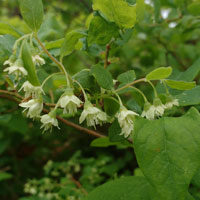Deerberry
Scientific name: Vaccinium stamineum

Photo credit: Holly Bickerton
Status
Threatened
“Threatened” means the species lives in the wild in Ontario, is not endangered, but is likely to become endangered if steps are not taken to address factors threatening it.
Date added to the Species at Risk in Ontario List
The Deerberry was already assessed as at-risk when the Endangered Species Act, 2007 took effect in 2008.
Read the most recent assessment report (PDF).
What it looks like
Deerberry is an upright, spreading, deciduous shrub that belongs to the Heath family, and is closely related to blueberries and cranberries. It rarely reaches more than one metre in height. The leaves of Deerberry are alternate, oval, dark green on top and a whitish colour underneath, with no teeth.
The young twigs are quite hairy but lose their hair and develop peeling bark with age. In early summer, Deerberry produces clusters of hanging white flowers. The fruit is a greenish-blue berry that contains a few soft seeds and ripens by August.
Where it lives
Deerberry ranges from New York State, Ohio and Missouri south to Florida and eastern Texas. In Canada, it only occurs in two areas in Ontario in habitats where the climate is moderated by its proximity to large bodies of water:
- the Niagara region along the Niagara Gorge
- the Thousand Islands east of Kingston
Where it’s been found in Ontario
Within Ontario, Deerberry is found predominately in dry open woods on sandy and well-drained soils growing under oaks, Pitch Pine or White Pine.
There are five extant populations of Deerberry in Ontario, most of them in the Thousand Islands region.
What threatens it
The two greatest threats to Deerberry in Canada are:
- fire suppression that leads to canopy closure and shading
- browsing by deer
Recreational activity may be a threat in that a number of the Deerberry populations are located near trails, leaving the species susceptible to trampling.
Action we are taking
Threatened species and their habitat are protected under Ontario’s Endangered Species Act, 2007 (ESA).
The ESA requires us to prepare recovery guidance for threatened species. All species listed on the Species at Risk in Ontario List may be eligible for consideration for government funding through the Species at Risk Stewardship Program.
Recovery strategy
A recovery strategy advises the ministry on ways to ensure healthy numbers of the species return to Ontario.
Read the executive summary (February 18, 2010)
Read the recovery strategy (February 18, 2010)
Government response statement
A government response statement outlines the actions the government intends to take or support to help recover the species.
Read the government response statement (November 18, 2010)
Five-Year Review of Progress
A five-year review reports on progress made toward protecting and recovering a species, within five years of publishing a species’ government response statement.
Read the report on progress towards the protection and recovery of 13 species at risk, including Deerberry (2015).
Habitat protection
General habitat protection - June 30, 2013
What you can do
Report a sighting
Submit your observations of species at risk to the Natural Heritage Information Centre (NHIC), which is Ontario’s conservation data centre. Join the centre’s Rare Species of Ontario project in iNaturalist, an online plant and animal identification app, to quickly and easily submit your observations.
Volunteer
Volunteer with your local nature club or provincial park to participate in surveys or stewardship work focused on species at risk.
Be a good steward
- Private landowners have a very important role to play in species recovery. If you find species at risk on your land, you may be eligible for stewardship programs that support the protection and recovery of species at risk and their habitats.
- Invasive species seriously threaten many of Ontario’s species at risk. To learn what you can do to help reduce the threat of invasive species, visit:
Report illegal activity
Report any illegal activity related to plants and wildlife to
Quick facts
- Deerberry is pollinated by insects and can spread by seed dispersal by birds and other animals, or by underground rhizomes that can form colonies covering several square metres.
- In the United States, Deerberry often occurs in habitats that are dependent on fire to persist, and it is believed that fire may play a role in seed germination. In Canada, Deerberry plants do produce seed but there is no evidence of seedling establishment.
- The scientific name for Deerberry – stamineum – comes from the Latin word for ‘stamen that stick out’. The flowers of this species have a stamen (pollen producing part of a flower) that extends well beyond the petals.